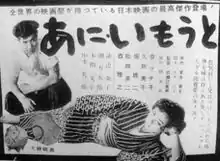Older Brother, Younger Sister
Older Brother, Younger Sister (あにいもうと, Ani imōto) is a 1953 Japanese drama film directed by Mikio Naruse. The film is based on the short story Ani imōto by Saisei Murō.
| Older Brother, Younger Sister | |
|---|---|
 Japanese film poster | |
| Japanese | あにいもうと |
| Directed by | Mikio Naruse |
| Produced by | Nobuo Miura |
| Written by |
|
| Starring | |
| Music by | Ichirō Saitō |
| Cinematography | Shigeyoshi Mine |
| Edited by | Toyo Suzuki |
Production company | |
| Distributed by | Daiei Film |
Release date |
|
Running time | 86 minutes |
| Country | Japan |
| Language | Japanese |
Plot
Mon, the elder daughter of a rural family, returns home from Tokyo pregnant after an affair with college student Kobata. Her parents fear a scandal that might threaten the marriage prospects of the younger sister San. Also, Mon, as the film suggests, supports San's education by prostitution, as the father's business had to close down and the mother hardly manages to finance the family by running a small store. The ill-tempered eldest brother Inokichi decides to take on the role of a disciplinarian, first beating up Kobata when he visits the family to apologise, and later Mon. Still, Mon forgives him and returns to the capital.
Cast
- Machiko Kyō as Mon
- Masayuki Mori as Inokichi
- Yoshiko Kuga as San
- Eiji Funakoshi as Kobata
- Kumeko Urabe as Riki, the mother
- Reizaburō Yamamoto as Akaza, the father
Reception
Film scholar Alexander Jacoby called Older Brother, Younger Sister an "uncharacteristically brutal film in which the emotional tensions […] explode into physical violence".[2] Film historian Donald Richie objected that by "attempting to move from realism to naturalism, Naruse is occasionally at fault in manipulating his characters a bit too obviously".[3] Keith Uhlich of Slant Magazine gave the film 3.5 of 4 stars for showing Naruse's "considerable skill at portraying household dynamics".[4]
Literary source
First published in 1934, Saisei Murō's short story Ani imōto had won the Bungei Konwakai Award and had been adapted for the screen the first time in 1936[5] The story has been translated into English by Edward Seidensticker and is available in the anthology Modern Japanese Stories.
References
- "Older Brother, Younger Sister at the Japanese Movie Database" (in Japanese). Retrieved 21 January 2021.
- Jacoby, Alexander (2008). Critical Handbook of Japanese Film Directors: From the Silent Era to the Present Day. Berkeley: Stone Bridge Press. ISBN 978-1-933330-53-2.
- Anderson, Joseph L.; Richie, Donald (1959). The Japanese Film – Art & Industry. Rutland, Vermont and Tokyo: Charles E. Tuttle Company.
- Uhlich, Keith (6 November 2005). "Older Brother, Younger Sister review". Slant Magazine. Retrieved 21 January 2021.
- Fujiki, Hideaki; Phillips, Alastair, eds. (2020). Japanese Cinema: Texts and Contexts. London and New York: The British Film Intsitute/Bloomsbury. ISBN 978-1-8445-7679-1.
External links
- Older Brother, Younger Sister at IMDb
- Older Brother, Younger Sister at the Japanese Movie Database (in Japanese)
- "Older Brother, Younger Sister at A Mikio Naruse Companion". Retrieved 21 January 2021.